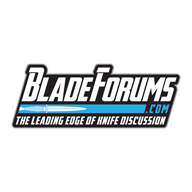Anyone taken a look at these or maybe even made with them?
I get my stuff from GFS anyway, so when they decided to have a couple of 'new' (really just tweaks to existing formulas, more or less) steels made over here specially I had to grab a 3mmx50mmx600mm bit of each to play with perfect for me doing stock removal only, but now I'm stumped for what to plunge for - they both look like they'll make great chef knives, or bushcraft knives, or carving/whittling knives depending on HT so I'm having trouble getting my muse to lead me.
Anyhow, basic specs below.
Sheffcut:
The Specs:-
Heat Treatment:-
Heat to 800 – 820C Hold for 10 minutes
Water or Oil Quench (Suggested oil is Rye 50)
Temper for two hours at 150C for 65HRc
Temper for two hours at 175C for 64HRc
Wolfram Special:
Exact Chemical Composition:-
Suggested Heat Treatments:
Heat to 815C and hold for 5 minutes (66HRc as quenched)
Oil Quench (Suggested Oil is Rye 32)
Temper twice for two hours at 200C for 64HRc
----------------------------------------------
Thanks folks, stay well!
Shaun/FloWolF
I get my stuff from GFS anyway, so when they decided to have a couple of 'new' (really just tweaks to existing formulas, more or less) steels made over here specially I had to grab a 3mmx50mmx600mm bit of each to play with perfect for me doing stock removal only, but now I'm stumped for what to plunge for - they both look like they'll make great chef knives, or bushcraft knives, or carving/whittling knives depending on HT so I'm having trouble getting my muse to lead me.
Anyhow, basic specs below.
Sheffcut:
The Specs:-
C | Cr | Mn | P | S | Si | Nb |
1.3% | 0.2% | 0.3% | 0.02% Max | 0.015% Max | 0.25% | 0.1% |
Heat Treatment:-
Heat to 800 – 820C Hold for 10 minutes
Water or Oil Quench (Suggested oil is Rye 50)
Temper for two hours at 150C for 65HRc
Temper for two hours at 175C for 64HRc
Wolfram Special:
Exact Chemical Composition:-
| C: | W: | Mn: | Cr: | Si: | P: | S: |
| 1.13% | 2.23% | 0.24% | 0.42% | 0.2% | 0.012% | 0.016% |
Suggested Heat Treatments:
Heat to 815C and hold for 5 minutes (66HRc as quenched)
Oil Quench (Suggested Oil is Rye 32)
Temper twice for two hours at 200C for 64HRc
----------------------------------------------
Thanks folks, stay well!
Shaun/FloWolF




